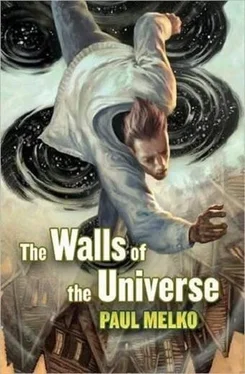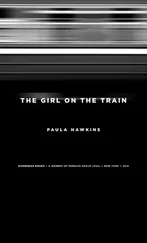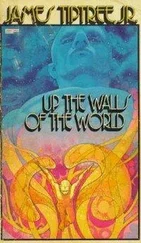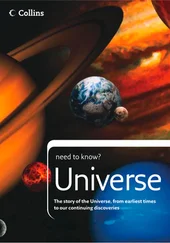They were tiny, but a dozen of them radiated from the crack, as if a tiny tool had been used to dig there. Why?
The door opened and John jumped.
“Hello there, working late, I see.”
John reached for the device to hide it but then felt that would look too suspicious. He turned, smiling. Professor Wilson stood by the door.
“Uh, yeah,” John said. He’d had almost no contact with his advisor and didn’t want any now.
“You’re the other Wilson, aren’t you?”
“Yeah, I am,” John said, regretting for the umpteenth time that Wilson was the name he’d latched onto when he’d met his faux father in this universe.
“What’s that you’re looking at?” Professor Wilson asked.
“Nothing, nothing important.”
Wilson peered around John at the device sitting on the microscope’s stage. He stared at it, then nodded slowly. John refused to explain or say more or remove it from sight.
“How are classes? Too hard? You were admitted with just a GED, correct? You and I had some question on how you’d handle the core physics classes.”
John gritted his teeth. He’d had no question of how he’d do, but Wilson had.
“No problems,” John said. “I’ve aced all the quizzes in physics and physics lab.”
“Good, good.” Wilson paused, still staring at the device. “Carry on.”
After Wilson had disappeared, John packed up the device and exited as quickly as he could.
They built the prototype out of the wood plank. Henry found a dozen more ball bearings at a local industrial supply store. John carved flippers out of wood and placed them so that a player could flip them from underneath. It was more work than an electric flipper, but it got the idea across. As he used the rasp and the file to carve the flipper, John realized that the shape and length of the flipper could be varied. The prototype was done by the end of the week.
It was clunky and hard work to play, but it was fun. John’s wrists ached after whacking at the flippers all afternoon. The crew-Henry, Grace, and John-spent the evening talking about how each component would work. Casey was busy with a project, but John kept glancing at the door, expecting her to show. After the first night, John added a spring launch mechanism, so they didn’t have to drop the ball in at the top.
“This is a lot more fun than those video games,” Grace said, referring to the ghastly Pong-like Electrux game in the Student Union.
“The prototype just proves that the ideas work,” John said. “Now, we have to ramp it up, so to speak.”
“That was bad,” Grace said.
“Grace,” John said. “I want you to build a flipper prototype. When the player presses a button, the flipper will move, about thirty degrees from here to here.” He showed her the angles with his hands. “Use a solenoid. It needs to be strong enough to launch a steel ball bearing two meters up an incline plane of ten degrees.
“Henry, I want you to build a prototype bumper. When a ball hits a bumper, it triggers a solenoid that bounces the ball back in the opposite direction.” He drew a diagram on the chalkboard, a triangle. “The first one should be about this size, but we’ll want to be able to make any shape of bumper. I’m going to work on sound, operation, and scoring. We’ll worry about flags and other crap later.”
“Flags?” Grace asked.
“More ways to score points.”
“How can you know so much about these things when I’ve never even heard of them?” Grace said.
“I spent a lot of time playing pinball… in Vegas,” John said.
Grace had a flipper done first, and John suspected that she had worked on it when she should have been working on her lab reports. They were all three working in the lab after dinner two days later when Grace called John over. She showed him a small red button mechanism that she held in her hand. Wires passed from it to a block of wood, where one of John’s carved wooden flippers was mounted.
“Watch this,” she said, and pressed the button. The flipper spasmed, the block of wood jumping.
“Wow. Kinda powerful.”
“Yeah,” she said, smiling at the thing. She made it hop a half-dozen times.
“Let me try,” John said. He took the button from her and pressed it, holding it down. The flipper jumped and came back to the starting position. “Is there any way to keep the flipper up while the button is depressed?”
Grace frowned. “That wasn’t in your list of requirements, John.”
“I’m sorry. I forgot that one. But I like this. It’s exactly what I had in mind otherwise.”
When John looked over Henry’s shoulder to check his work, he pointedly stopped what he was doing.
“You may want to tighten that…”
“It’s not ready yet.”
John shrugged and let him have his peace. Managing a team was tough work, he decided, so he returned to tracking down a quarter box and designing an underlaying physical and electrical framework. He could have used Casey’s help, but she had begged off again.
Henry was a mechanical engineer. He’d worked in his father’s auto garage as a kid, and knew how to weld. He built a table in no time, one that opened up as John suggested so that they could easily work with the electronics underneath the table.
“Every solenoid that clicks may need to trigger a sound and a score,” John explained.
They built a row of bells and buzzers into the base of the thing, and a backboard that housed a small analog scoreboard. Within a week their prototype could rack up a score and emit sound when they touched various triggers on the play field.
Two weeks later, Henry put two of Grace’s flippers into the play field and they played for an hour before the right flipper’s solenoid burned out.
“Crappy equipment,” Grace said, pulling the mechanism out and poking at it with a soldering iron. “It worked for a while. Not bad, I say.”
“Neat,” Henry said. “I’ll have a bumper for tomorrow. We can put it here.” He pointed to a spot next to the flipper. A wooden bumper sat there now.
“This is coming along very nicely,” John said. “We need a ball return mechanism.” When the ball fell out the bottom of the play field, it landed in a cup. Players manually picked it up and put in the launch lane.
Henry nodded. “I’ve got some ideas on that.”
Grace said, “Why don’t we have two boards back-to-back for double play?”
“What?”
“Pinball is fun, for one person. Why not put two boards together, with a player at each end, with the goal of trying to get the ball in the other person’s drop area?”
“Mechanical soccer,” Henry said. “Neat.”
“That’s not traditional pinball,” John said.
“So?” Grace said. “We don’t have to build a traditional pinball machine, do we?”
John nodded. “I guess we don’t. We’re doing this for fun.”
“All right.”
The next night, they tore off the backboard and built another play field. They decreased the slope a bit.
“You know,” Grace said, “it would be better if there were several sets of flippers; then you could pass the ball back and forth.”
John shook his head. “Let me tell you about foosball,” he said with a laugh.
“Yeah?”
“Never mind.”
The next time he came to the lab, John did so after midnight. He wanted no one to interrupt him, especially Wilson. The lab was dark and empty. John opened his lab book on his desk and scattered some experimental data around to act as cover if anyone came in. Then he turned on the spectrometer. He’d seen it on one of his casual tours of the lab: a brand-new gamma ray spectrometer from Aggison-Hewlett.
He’d borrowed the spectrometer notes from a guy who’d taken the nuclear physics lab class the semester before. It had a simple procedure for calibrating the spectrometer, then taking and printing a spectrum.
Читать дальше












